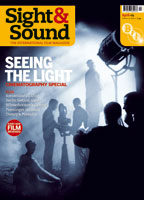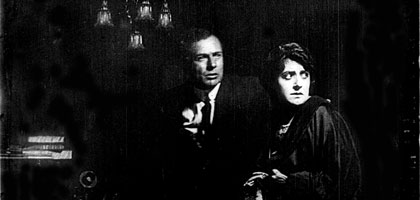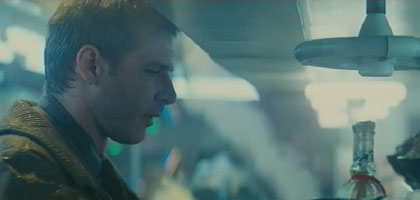Primary navigation


Barry Salt charts the technical and artistic developments in lighting that have transformed the look of cinema over the past century
For the first few years of the cinema, there were no cameramen. The first film-makers did everything themselves, from thinking up the story to building the sets, directing the actors, framing the shots and working the camera. People like Georges Méliès and George Albert Smith were very talented, intelligent, creative and skilful individuals, and could manage all this with ease. The lighting of the scenes they shot was provided either by direct sunlight in the open air or by diffused sunlight inside the glasshouse studios built by Méliès and other film-makers after him.
As films began to be made up of more than one shot, from 1903 onwards, specialist camera operators became the norm. The worldwide cinema boom of 1906 required more and more films to fill the Nickelodeons, so standardised lighting conditions in the big glasshouse studios were needed to allow filming during more of the daylight hours. This meant that supplementary artificial light - usually from specially adapted street-lighting arcs - came to be added to the diffused sunlight. A single arc floodlight could be used alone to cast a pool of light into one area of a dark scene to create a sinister mood, and thus from around 1912 the expressive use of film lighting was under way.
For exterior scenes, meanwhile, a new approach called 'back lighting' had appeared in 1910. This involved shooting with the sun shining towards the camera and onto the backs of the actors, rather than from behind the camera onto their faces. Under the harsh, bright sunlight of California, back lighting had to be combined with sunlight bounced back into the actors' faces from white reflecting sheets below the camera to avoid their features being shrouded in black shadow.
This approach was taken inside the film studio about 1914: the light from the back now came from theatrical-type arc spotlights that put a narrow-focused beam of light onto the actors from behind; the light from the front onto the actors' faces came from arc floodlights, rather than reflected sunlight.

Up until this point, the actors and the film set had been lit as one whole. But over the years of World War I, a new basic concept of film lighting formed in American cinema in which the set was lit to look its best, and extra lighting then added solely on the actors to make them look their best. While European cameramen continued with the former style of lighting, American cinematography moved into the leading position that it held for most of the 20th century. New cameramen who had been top-level professional stills photographers came into the film industry during the war years and showed what could be done with a careful choice of lighting angles. One of them was Charles Rosher, who was contracted by Mary Pickford to photograph the films she starred in and produced.
The 'soft focus' effect gradually crept into cinematography from stills photography at the same time. The most extreme use of this 'artistic' blurring of the scene occurred in D.W. Griffith's Broken Blossoms (1919) under the influence of Hendrik Sartov, who went on to replace Billy Bitzer as Griffith's cameraman. Varying degrees of soft focus became the norm in US cinematography through the 1920s and gradually spread to Europe.
As film scenes were divided up into more and more close shots of the actors, the way cameramen lit the human figure became standardised. There was the 'key' (or main) light, usually a spotlight, whose angle defined the shape of the face; the 'fill light', usually a floodlight, which lightened the shadows cast by the protuberances of the face; and finally the back light, as already mentioned. This has come to be referred to as 'three-point lighting', but actually it was quite common in American films of the 1920s to have two back lights, one from either side of the head, so giving a kind of 'four-point lighting'. You can see this in Paramount films from around 1925, such as Are Parents People?, but cameramen at other studios did it too. The essence of 'glamour lighting' was produced by having the key and fill lights close to the camera on both sides and at almost the same intensity, with the back lights also close together in the opposite direction - together with heavy soft focus, of course.
Most film directors left the composition of the film frame up to their cameraman, and the cameramen got their ideas almost entirely from the conventional pictorial art of the past. The extremely rare instances of the influence of recent modern art on cinematography are due to the handful of great directors who decided for themselves what the shot should look like. The first of these was Fritz Lang, who took his ideas from geometrical abstract art; the next was Sergei Eisenstein, whose compositions derived entirely from his personal synthesis of avant garde art and owed nothing to his cameramen.
In the 1920s there was also a wave of interest in the more extensive use of camera movement (tracking, panning and tilting), led by European film-makers such as F.W. Murnau, with The Last Laugh (Der Letzte Mann, 1924). This meant that operating the camera became a more demanding task, and a dedicated camera operator became necessary. The operator worked under the control of the principal cameraman, who now devoted all his attention to lighting the scene, and so was called the 'lighting cameraman' inside the film industry, to distinguish him from this new 'camera operator'. And the camera operator had an assistant, or 'focus puller', to make the frequent changes to the lens focus required by these extra camera movements.
In the 1930s all the features of cinematography described above were refined into a norm of technique, from which there was very little visible deviation. The Europeans picked up the American innovations, though they tended to use a slightly smaller number of lights to achieve them. Nevertheless, there was some experimentation going on, mainly in trying to get greater depth of field into the shot. This exploded in Gregg Toland's photography of Orson Welles' Citizen Kane (1941). Toland achieved deep focus by using wide-angle lenses and powerful lights, but the most visibly distinctive feature of his cinematography was the high contrast in the illumination. He dropped the use of fill light on the actors' faces, leaving dark shadows around their prominent features, which went entirely against the standard photographic style of 1930s films. The lighting of Citizen Kane was so far away from the norm that it had little immediate influence, though the use of low angles with a slightly wide-angle lens was used by William Daniels in The Keeper of the Flame (1942), and the unfilled black shadows were imitated by Lee Garmes in Since You Went Away (1944). A more diluted version of Toland's techniques can be seen in some 1950s films, such as The Gunfighter (1950).
In the 1950s, black-and-white film was increasingly replaced by colour, but this too had only a limited effect on cinematography. From the appearance of Technicolor in the late 1930s, the standard response of cameramen to shooting colour was to keep some back lighting, but to decrease its intensity. This meant that the films still looked good when shown in monochrome on television.

It was only in the 1960s that there was another truly fundamental development in lighting. And for the first time European lighting practice had an effect on American cameramen, or 'directors of photography', as they now liked to be called. The leading new figure was the photojournalist Raoul Coutard, who was engaged by Jean-Luc Godard to photograph his first feature, A bout de souffle (Breathless, 1960). Godard wanted it to be filmed exclusively with the 'available light' naturally existing in location interiors. Coutard did this by shooting with very fast film and having it specially processed to increase its sensitivity still further.
After this, Coutard made things easier on himself by invisibly supplementing the natural light inside real rooms with small floodlights bouncing their light off the ceiling. This use of indirect or 'soft' light became the major alternative to the standard 'direct' lighting, where light from the source went straight onto the subject. Soft light comes from bouncing light around white surfaces inside a very large lamp, emerging as the equivalent of the light from the sky coming into a room through a window, casting hardly any shadow. Such light can also be created by shining powerful lights through a large sheet of translucent material: this was the way David Watkin lit Peter Brook's Marat/Sade (1966). Others starting the soft-light trend in the US were Alfred Hitchcock, who demanded it for Torn Curtain (1966), and Haskell Wexler lighting Norman Jewison's The Thomas Crown Affair (1968).
Handheld camerawork also became important for the first time in the 1960s, either to speed up production or to amplify the excitement, as in the New Orleans sequence in Easy Rider (1969). Major innovation in ways of supporting the camera continued into the 1970s with the invention of the Steadicam mount, which made all sorts of smooth tracking shots possible, delighting directors with new stylistic possibilities, as demonstrated in Bound for Glory (1976) by its inventor, Garrett Brown. The Steadicam also delighted film accountants with the savings it brought by eliminating the protracted business of laying tracks for the camera dolly.
In the 1980s, many film-makers rejected the natural, 'correct' response of colour film to real-world colours that Eastman Kodak had always striven for. Instead they put colour filters on the camera lens, used coloured light or made changes to the developing process in the film laboratory. A major topic in the professional discussion of film lighting was the search for a special 'look' for a film and how to achieve it - cinematographers were now very eager to put their own mark on films, and these special treatment techniques did just that.
The heavy use of smoke in film scenes became more common through the 1980s, even when implausible dramatically. One of the decade's most influential pieces of lighting was Jordan Cronenweth's work on Ridley Scott's Blade Runner (1982), which used smoke relentlessly. Scenes were frequently backlit using very strong beams of light or with sources of light within the shot, producing what is effectively a blurred wall of light behind the actors that is brighter than their faces. Scott said that the idea came to him from Citizen Kane - specifically, I presume, from the screening-room scene. In the past, cameramen had always avoided having the actors' faces underexposed, as they had always kept the background less brightly lit than the actors.
Today the major divide in the description of cinematographers' lighting styles is between the use of soft and hard (direct) light. At one extreme of the spectrum, we find the ultimate in soft lighting from David Watkin in Sidney Lumet's Critical Care (1997). At the other extreme, one could mention Anthony B. Richmond's work on Candyman (1992), which is mostly done with hard light without much diffusion, either on the lights or the camera lens.
But nowadays pretty much anything goes: all the lighting styles I have described can be and are used, plus distortions of colour, shape and speed.